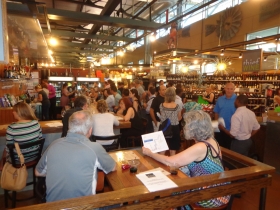Lessons from the Public Market
Could its success provide a model for the Grand Avenue Mall?
If you wanted some measurement of how badly the Grand Avenue Mall has declined, consider the fact that its owners are seeking an opening bid of $4.75 million in an auction they’ve discussed having. As recently as 2005, it was sold for $31.7 million and its value by then was probably far below its late 1980s peak.
The Grand Avenue is “a white elephant,” says real estate developer Ron San Felippo. “It needs to become a success if that downtown neighborhood is ever going to be turned around.”
San Felippo has joined an effort led by Godrey & Kahn attorney Stephen Chernoff to use a non-profit group — the WAM DC LLC formed a year ago with the goal of revitalizing western Wisconsin Ave. — to purchase the Grand Avenue Mall and transform it, drawing on the success of the Public Market.
“Ron has been instrumental in turning that around,” says Chernoff. “I think his expertise will be very helpful.”
San Felippo became the key person overseeing the Public Market in 2007, working with the Third Ward Business Improvement District and the Historic Third Ward Association. At the time, the market was floundering. Today, it’s a big success. So how did that happen and what might the Grand Avenue learn from this?
“The original intent for the Public Market was to have pure approach, a fresh-ingredient market with little you could buy that was packaged or prepared,” San Felippo notes.Thus, the St. Paul’s Fish Market couldn’t serve sit-down meals.
“85 percent of all the stuff that was there in 2007 is still there,” San Felippo says. The added vendors helped, but it was more about transforming the approach for the original businesses. In addition, the market had success bringing in volunteers to help out.
San Felippo’s approach, he says, mixed three things: “Common sense, a sense of humor, and organized chaos.”
It’s certainly worked. Last year, the market attracted 1.2 million visitors, including a lot of suburban parents with kids on weekends, and tourists who walk down from the train station, San Felippo notes.
“And we have reached across the great divide, we’re getting a lot more people from north of the freeway,” meaning Downtown residents. The physical separation between Downtown and the Third Ward caused by I-794 has made it very difficult to knit the two neighborhoods together. “It cut Downtown in half,” San Felippo says. “We’re working with the DOT (State Department of Transportation) to increase lighting and use painting, artwork, under the freeway bridge, so it’s not a dark, you’re-going-under-a-bridge atmosphere.”
At this point, he says, the Public Market is such a success, “if I had three times more space I could fill it up.” Those retailers could be attracted instead to the Grand Avenue, if it could be transformed from its current state of white elephantitis. So what can it learn from the Public Market?
A non-profit works better: “When it’s a community asset and not a real estate investment, its easier to get volunteers to help out,” San Felippo says. You can also take more risks if you don’t need to make a profit — you can bring in arts or entertainment groups, he notes, who may not be able to pay that much for rent, but can generate traffic. And a non-profit can get cheap financing. San Felippo expects the city or its Redevelopment Authority will issue low interest bonds that will greatly lower costs.
Food is a key draw: “The Grand Avenue food court is very successful,” San Felippo notes, and could be expanded. And then you build on that success, offering retail products to people coming into and out of the food area. “You already have a client flow you can build on… You want a mix of food and retail and artists.”
The customers are always right. The switch from a pure fresh market approach, he notes, meant “we were offering a product that people wanted to buy rather than deciding what people should want to buy.”
Messy is good: “We wanted organized chaos, messy with no straight lines. We tried to change it up so there’s always something new.” A mall with lots of traffic is chaotic but exciting.
Of course the Grand Avenue is a 450,000-square-foot shopping center compared to the 14,000 square foot Public Market. That’s 32 times more space to fill.
But San Felippo and Chernoff and others involved in the effort expect the mall will only be partly retail. San Felippo believes much of the mall’s upper floors could be rented to educational groups of various kinds.
San Felippo also suggested the mall might rent to the Milwaukee Police Department, for a downtown police station. Chief Ed Flynn has in the past suggested a police station on Wisconsin Avenue. “And could the Convention Center use some of the space?” San Felipppo wonders. “They’ve talked about needing to expand.”
With flexible approach to rentals, and no need to make a profit, “the mall should be able to pay its debt service and all of its operating costs,” San Felippo predicts. “The building is already there. The incremental costs are to build it out.”
“And you need to open up the first floor retail to the street,” he adds. “And open a connection to (Zeidler Park) across the street.”
Finally, San Feliippo believes the Public Market and Grand Avenue can achieve some synergies by working together. The market, he notes, gets asked to hold events that are much too big for it and would work better at the Grand Avenue
Chernoff says his non-profit group is in the midst of a “pretty delicate negotiation” to purchase the mall. Whether San Felippo’s ideas will all work remains to be seen, but having local management by people who care about the city sounds like a better idea than a mall run by some faceless out-of-town corporation.
However, it’s still not certain who the final management team will be. Chernoff suggests the mall could end up as a joint venture, with some of it run by a for-profit company and some of it by a non-profit. But whatever the final structure of the management, it won’t be running a traditional shopping mall. That, Chernoff emphasizes, is “deja vu all over again,” and would be certain to fail.
Short Takes
-Among other key leaders working with Chernoff are Julia Taylor, president of the Greater Milwaukee Committee; Gary Grunau, co-owner of Schlitz Park and Bob Monnat, chief operating officer of development firm Mandel Group Inc.
-One thing that will help bring customers to Grand Avenue is the new project to transform the long underused Posner Building into an apartment complex with 105 units.
-San Felippo recalls that when the Public Market opened, “Mark Belling railed about what a white elephant it would be and how the public would end up having to subsidize it.” I’m guessing Belling may condemn this Grand Avenue effort as well. That might be a good sign.
Murphy's Law
-
National Media Discovers Mayor Johnson
 Jul 16th, 2024 by Bruce Murphy
Jul 16th, 2024 by Bruce Murphy
-
Milwaukee Arts Groups in Big Trouble
 Jul 10th, 2024 by Bruce Murphy
Jul 10th, 2024 by Bruce Murphy
-
The Plague of Rising Health Care Costs
 Jul 8th, 2024 by Bruce Murphy
Jul 8th, 2024 by Bruce Murphy























Actually, Belling was write about the Public Market. Had it stuck to its original business plan I don’t think it would have survived and people who ran that market stubbornly stuck to that plan while many were suggesting that they allow some of the changes that they eventually made.
The original plan was not all that well thought out, but it was idealistic. This was compounded by the fact that the people who were running it decided to create something that appealed to their sensibilities rather than something that could survive. For some reason they didn’t recognize that a customer could go to a Metro Market or Sendiks and get all the same stuff in a more convenient fashion.
Once the Public Market started to LISTEN to what people wanted they started to do well.
So that’ll be the key thing with the Grand Avenue. If they stop trying all the same things and actually listen to the marketplace (instead of the Greater Milwaukee Committee Echo Chamber) you might actually be able to revive it.
Interesting ideas. At this point they really need to re-brand the mall. Completely re-think the focus. Let’s face it, people are not going to go out of their way to deal with downtown streets and parking garages to go to TJ Maxx. They need to find a way to get unique retailers in there, and to do that, they need to re-invent the place.
After reading this, I’m wondering if it might not be an interesting idea to make the mall into an addendum of the public market. Take a sector and fill it with food and cooking related retailers. Have big events there. Put a bunch of unique restaurants in. Give the mall a theme.
Another option would be to try and attract smaller third ward/bay view style boutique stores in there.
Whatever they do, they will need to think outside the box to save the ailing mall. Right now its in a downward spiral and seems toxic to new stores.
About very 20-30 years retail changes dramatically. North Ridge and Grand ave found that out. Brookfield Square never kept up with the times, Mayfair did. Now Brookfield is keeping up but Grand Ave. just lost. Convert to loft apt.s with some shops and offices.
As to the entertainment component, why not have Marcus put a multi-screen theater in a segment of the mall along with a place for local talent to perform. People could wonder throughout mall partaking of it’s offerings while waiting for a movie or spending time there after a film.
I think it would be a great idea if the old Grand Avenue could become and extension of the Milwaukee Public Market. The Milwaukee Public Market has become such a huge success, and the Grand Avenue has the space to fill with unique food stores, restaurants, and stores like Williams Sonoma, Sur la table, wine places, cheese places, meat stores and a menagerie of unique food stores. The Plankinton Arcade would make a wonderful location for such type of stores and restaurants with cafe type seating in the open area of the arcade. I could be an amazing tourist draw along with a huge draw for locals for breakfast, lunch, and light dinners.
I agree Steve. Actually the GA would have been a great Public Market. It needs to be opened up to the street. I also agree with WCD. A mixed use development with offices and residences on the upper floors.
Mark Belling is a naysayer of anything new and modern in Milwaukee. Belling or Sykes are clearly not the beacons we should follow. It’s incredible how many politicians listen to Belling and Sykes and are swayed by their 50,000 watt voices. Belling shot down the tear down of the Park East Freeway – yet slowly but surely we see new developments in this area. Belling was selfish in his ideas. All he wanted was a quicker ride to his condo downtown. But I digress.
The GA is going to need a bold new vision. We must bring in new traffic for anything to succeed. Start with new condos overlooking Wisconsin Avenue and the River and possibly south ( maybe tear down that other monster “freeway” to the south ), close off Wisconsin. Make it a pedestrian mall. Eventually – bring the Trolley right down the middle ( like Minneapolis ). Let’s stop depending on the big box stores. Those don’t work downtown. Then with all that in place or before – being a public market “like”model but make it very different. And yes the Public Market as is everything near it is very very successful. What a great atmosphere. It feels very like the Northwest public markets. The key – increase demand. And make the parking really easy – and out in the open- not like the current parking situation we see at the GA.
One thing that all of the failed malls, Northridge, Grand Avenue and Midtown Center, have in common is that they are patrolled by the City of Milwaukee Police Department. Mayfair, Bayshore, Southridge, Brookfield Square are all patrolled by suburban police departments. Let’s have the Milwaukee County Sheriff’s Department take over as the primary law enforcement agency at Grand Avenue. Although I have reservations about how they handle some situations at Milwaukee’s Lakefront, they have been very effective at improving the overall experience for most people there.
I lived and worked in downtown Milwaukee from 1979 through about 1990 previous to any of the residential condo development. The Grand Avenue Mall served the workforce population of downtown Milwaukee, when there was one.
Refurbish the Plankinton Building public space back to the beautiful state it was in when renovated in the 1980s and move those damaging ‘bigbox’ spaces into the vacant mall space. The Plankinton could function very well on its own as an extension of a public market – it already did that before that disruptive renovation that shut down the free-flow of all-season pedestrian traffic that the building was designed with.
I notice that nobody so far has mentioned the perennial problem that the Grand Avenue has had from the beginning: it is downtown, it attracts black customers, and a certain element of Milwaukee-area residents (and some tourists) will not go anywhere they see as having “too many” black people not in positions of servitude but acting like they are as good as anybody else. And if there are more than two black teens or young men at one time… OMG, call the talk radio guys, the Negro Menace has destroyed everything again!
In some ways, this town is stuck in Harold Breier days, and some folks don’t have a problem with that.
The range of ideas offered here is encouraging.
As Dan says above, the traditional mall approach isn’t working; you won’t attract suburban shoppers to TJ Maxx or a truncated Boston Store. Hurrah for the 20,000-plus downtown residents; in urban-planning circles that’s considered the core needed to support markets, drugstores and other neighborhood services (now let’s try and double that number.)
What the existing Public Market, Third Ward, Brady Street and other lively places demonstrate, is that people will be attracted to an experience they can’t get at Mayfair.
So as Dawn points out above, traffic generators are needed: theater, conventions, sports events, etc., are all good. Food is even better. I’d suggest a mix of restaurants, bars and retailers: a high-end grocery like Glorioso Bros. next to a takeaway deli adjoining food stalls would pack ’em in. I quote a line from an old movie comedy – “what people gotta, is eat.”
Your model could be Seattle’s Public Market (a/k/a Pike Place), which covers seven or eight blocks of valuable real estate. As an attraction and traffic-generator, it’s unmatched. One notable point at Pike Place: chains and franchises are forbidden (Starbucks and Sur le Table get a pass because both started there.)
Oh, let’s also find a deep-pocketed movie-lover to revive the handsome Warner/Grand theater. With so much open and underused space adjoining the building, it could be the nucleus for a multi-screen ‘movie city’ – another way to generate pedestrian traffic. (And doesn’t anyone else find it curious that in a city of 600,000-plus there are so few movie screens?)
One of the things I’ve always loved about Milwaukee is that, despite a streak of stodginess, it’s always interested in trying new things. This pending sale and a re-think of purpose could mean a great revival for Grand Avenue.